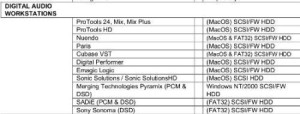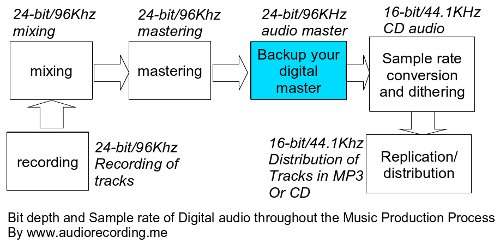This post summarizes the industry standard practices in music production and audio recording. These are commonly referring to the recording labels, recording producers, recording engineers, audio mixing engineers and audio mastering engineers. These recommendations are formulated to bring order and maintain a certain level of quality standard for recording work.
Going down to independent and amateur level, most of the beginners practicing music production in their own bedroom does not know that these standard or recording practices exists. What will happen is that they will search the Internet for information. Sometimes this information may not actually be the accepted standard or the authority. Hence the novice producer and engineer may experience problems in delivering the master recording to the main players in the recording industry.
One of the most important technical specifications for recording delivery is entitled: “Recommendation for delivery of recorded music projects” authored by the Nashville members of the P&E Wing of The Recording Academy in cooperation with the Audio Engineering Society’s Technical Committee on Studio Practices and Production (AESTD1002.1.03-10). This technical document contains one of the most important information as to what the major players in the recording and music industry are practicing when it comes to storage and delivery of music projects. The original document is technical in nature and very long. But this blog post will summarize the learning’s in a friendly manner so that it can be understood even to a beginner in audio recording. This is only the first part and the rest of the recommendations will be discussed in future blog post.
Recording bit-depth and sample rate recommendations
1.) When doing backups of your finished master (“master” means a complete music production work for which derivatives of it can already be used commercially and to be played in most all broadcasting mediums- radio, TV, etc.); the bit depth and resolution should be higher than the master. The document listed the following bit depths, sampling rates and guides for storing your digital audio master:
a.) Minimum of 24-bit depth.
b.) Minimum sampling rates:
88.2 KHz, 96 KHz, 176.4 KHz, 192 KHz, 352.8 KHz, and 384 kHz
c.) Not yet implemented or applied with any dithering and sampling rate conversion techniques.
Note: You should keep a higher resolution or “unaltered” copy of your master (the minimum is 24-bit/96KHz). The primary reason is that in the future; if you are planning to re-distribute a copy of your songs to a recording label, etc. You simply need to base from a high resolution copy of your master to create the best quality copy of your work for distribution.
This copy of master can be taken from the audio mastering process. Refer to the flow chart below:

To have the best quality as possible of your music production project using digital recording techniques, you need to record at least 24-bit/96KHz. Then this bit depth and sample rate is the same throughout the audio mixing and mastering process. After mastering, you will save a backup copy of your digital master. To be distributed to music store outlets, you will base it from the high resolution master which will be applied with dithering and sample rate conversion. It will then be available as 16-bit/44.1KHz used by CD and MP3.
The Master Delivery Media Storage Standard
See table below:

In the primary delivery and storage of master, it mostly recommends MacOS as the operating system for music creation using the following software: Protools, Nuendo, Paris, Cubase, Digital Performer, Logic, Sonic Solutions. The storage media will be hard disk drive using SCSI technology (Small computer system interface). According to the recommendations, it will accept ATA/IDE Hard disk drives provided it has a firewire enclosure. When transporting master from one location to another, the hard disk drive should be placed in shock proof cases. Looking at the table, there is only one DAW supported by Windows which was recommended by the committee and that is Pyramix.
Author opinion: If you have observed there are quite a lot of users which are not using Mac OS as their digital audio workstation operating system. The committee should also include Windows operating system as one of the recommendations. It is because those mentioned software are cross platform (can run either Mac or PC). Also a lot of decent software which are not included for example Reaper and Adobe Audition which have fairly large user base. In addition, common external hard disk drives for backup use are using USB connectivity. Most likely in the near future, these recommendations would be revised to anticipate some changes in the recording technology.
Definition of a “Master” & “Track”
Deep down to the novice home music production level, “master” is commonly understood as the final output of the mastering process while “track” is the name of each song in the CD album. But this is not only the case how the leaders of the recording and music production industry are defining these terms.
If you are hired to become an engineer or a producer in a major label, knowing intimately these two terms are very important. This will avoid miscommunication issues between you and the recording label.









One response
interesting